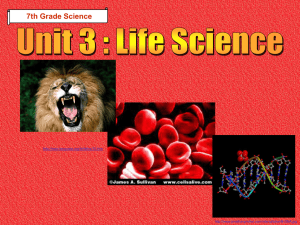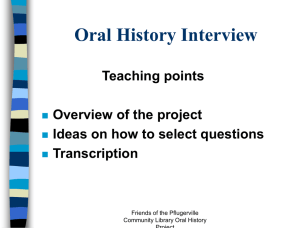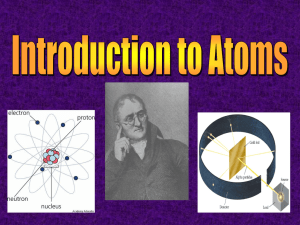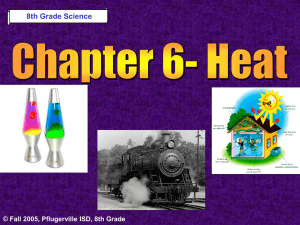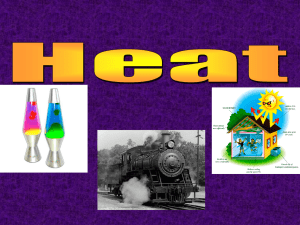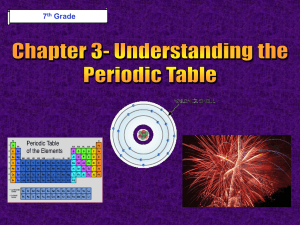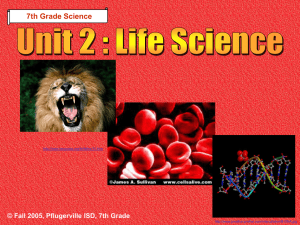Biological_Organization
advertisement
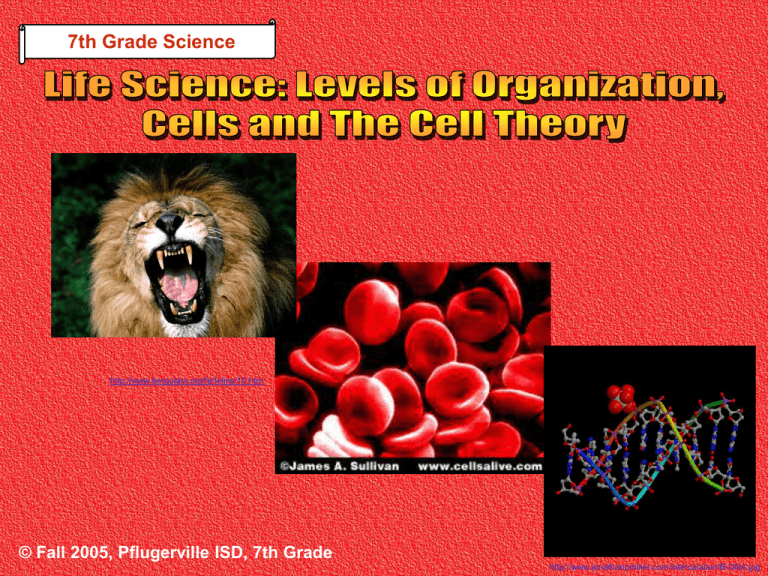
7th Grade Science http://www.bergoiata.org/fe/felins/10.htm © Fall 2005, Pflugerville ISD, 7th Grade http://www.jonathanpmiller.com/intercalation/B-DNA.jpg It’s Alive!! Or, Is It? What Do You Think? What characteristics do all living things have in common? © Fall 2005, Pflugerville ISD, 7th Grade Unit 2 : Chapter 7 : Section 1 It’s Alive!! Or, Is It? There are Six Characteristics of Living Things. 1. Living things have Cells. 2. Living things Sense and Respond to Change. 3. Living things have DNA. 4. Living things Reproduce. 5. Living things use Energy. 6. Living things Grow and Develop. © Fall 2005, Pflugerville ISD, 7th Grade Unit 2 : Chapter 7 : Section 1 It’s Alive!! Or, Is It? 1. Living Things Have Cells • • • • Every living thing is made up of one or more cells. Cells are the simplest collection of matter which has all the properties of life. Some cells specialize to do specific jobs. Examples are nerve cells, muscle cells, etc… © Fall 2005, Pflugerville ISD, 7th Grade Unit 2 : Chapter 7 : Section 1 The Cell Theory • The 3 Basic Components of the Cell Theory : • 1. All organisms are composed of one or more cells. (Schleiden & Schwann)(1838-39) • 2. The cell is the basic unit of life in all living things. (Schleiden & Schwann)(1838-39) • 3. All cells are produced by the division of preexisting cells. (Virchow)(1858) © Fall 2005, Pflugerville ISD, 7th Grade Modern Cell Theory • Modern Cell Theory contains 4 statements, in addition to the original Cell Theory: • 1. The cell contains hereditary information(DNA) which is passed on from cell to cell during cell division. • 2. All cells are basically the same in chemical composition and metabolic activities. • 3. All basic chemical & physiological functions are carried out inside the cells.(movement, digestion, etc) • 4. Cell activity depends on the activities of subcellular structures within the cell(organelles, nucleus, plasma membrane) © Fall 2005, Pflugerville ISD, 7th Grade It’s Alive!! Or, Is It? There are 2 main types of cells. 1. Prokaryotic Cells - have no nucleus - found in the kingdom of Monera - Examples are bacteria. http://library.thinkquest.org/C004535/media/prokaryote.gif © Fall 2005, Pflugerville ISD, 7th Grade Unit 2 : Chapter 7 : Pre-AP It’s Alive!! Or, Is It? There are 2 main types of cells (cont…). 2. Eukaryotic cells - have a true nucleus (that contains DNA) - found in more complex kingdoms (animal, plant, etc…) http://www.ccnmtl.columbia.edu/projects/biology/lecture1/images/F04071s.jpg © Fall 2005, Pflugerville ISD, 7th Grade Unit 2 : Chapter 7 : Pre-AP © Fall 2005, Pflugerville ISD, 7th Grade It’s Alive!! Or, Is It? 2. Living Things Sense and Respond to Change. • A stimulus is a change that causes the activity of an organism to change. • A stimulus can be internal (from inside). – Examples are fever or vomiting when sick. • A stimulus can be external (from outside). – Example is squinting when the lights are bright. © Fall 2005, Pflugerville ISD, 7th Grade Unit 2 : Chapter 7 : Section 1 It’s Alive!! Or, Is It? 2. Living Things Sense and Respond to Change (cont…). • Homeostasis is the maintenance of a stable internal environment. - Our bodies are very good at controlling the chemical reactions that keep us alive. These reactions can only take place when conditions are exactly right. - Even though our outside conditions may change, homeostasis keeps our internal conditions the same. - Example is body temperature. © Fall 2005, Pflugerville ISD, 7th Grade Unit 2 : Chapter 7 : Section 1 It’s Alive!! Or, Is It? 3. Living Things Have DNA. • • • DNA stands for deoxyribose nucleic acid. DNA is the molecule that controls the functions of a cell. DNA is passed from parent to offspring. © Fall 2005, Pflugerville ISD, 7th Grade Unit 2 : Chapter 7 : Section 1 It’s Alive!! Or, Is It? 4. Living Things Reproduce. • • • Most living things reproduce by sexual reproduction. Sexual reproduction requires two parents that produce offspring that share characteristics of both parents. Sexual reproduction produces more diverse more diverse offspring. Animals http://www.jpbutler.com/thailand/images/elephant-and-baby.jpg © Fall 2005, Pflugerville ISD, 7th Grade Unit 2 : Chapter 7 : Section 1 It’s Alive!! Or, Is It? 4. Living Things Reproduce (cont…). • • • Some things reproduce by asexual reproduction. Asexual reproduction occurs when a single parent produces offspring that are exactly the same as the parent. This leads to more uniform offspring. Hydra http://universe-review.ca/I10-26-hydra.jpg © Fall 2005, Pflugerville ISD, 7th Grade Unit 2 : Chapter 7 : Section 1 It’s Alive!! Or, Is It? 5. Living Things Use Energy • • Metabolism is the total of all of the chemical activities that the organisms performs. Metabolism includes: - Making food. - Breaking down food. - Building cells. - Moving materials in and out of cells. http://www.faculty.ucr.edu/~insects/systems/metabolism/metabolism.gif © Fall 2005, Pflugerville ISD, 7th Grade Unit 2 : Chapter 7 : Section 1 It’s Alive!! Or, Is It? 6. Living Things Grow and Develop. • • • You grow as your body gets bigger. Developing is the process of changing, maturing, and going through different stages. Growing and developing depends on the environment and the resources available. © Fall 2005, Pflugerville ISD, 7th Grade Unit 2 : Chapter 7 : Section 1 Levels of Organization largest smallest cell © Fall 2005, Pflugerville ISD, 7th Grade Made from Atoms and Molecules Hierarchy of Structural Organization • • • • • • Chemical Cellular Tissue Organ Organ System Organism Note: be able to define each! © Fall 2005, Pflugerville ISD, 7th Grade Essential Concepts: The Hierarchy of Structural Organization • Chemical – Atoms & bonds – Carbon, oxygen, hydrogen, etc. • Molecules – – – – – – • small inorganic small organic proteins carbohydrates lipids nucleic acids Cell Organelles - from various molecules © Fall 2005, Pflugerville ISD, 7th Grade Essential Concepts: The Hierarchy of Structural Organization • • Cellular level – – Cells – the basic structural and functional units of the organism – Cells are specialized for particular functions, e.g., muscle cells are specialized for contracting GnRH cells Tissue level – Groups of different cell types cooperate to perform specific functions skeletal muscle tissue © Fall 2005, Pflugerville ISD, 7th Grade Essential Concepts: The Hierarchy of Structural Organization • Organ level - two or more different tissue types organized to perform specific functions • System level connected organs that cooperate in related function(s) © Fall 2005, Pflugerville ISD, 7th Grade Hierarchy of Structural Organization • Organism level - all of the organ systems working together to maintain life constitute the living organism © Fall 2005, Pflugerville ISD, 7th Grade
